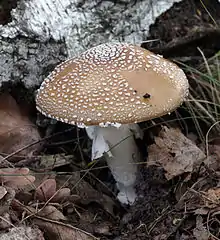Amanita pantherina
Amanita pantherina, also known as the panther cap and false blusher due to its similarity to the true blusher (Amanita rubescens), is a species of fungus found in Europe and Western Asia.
| Amanita pantherina | |
|---|---|
 | |
| Scientific classification | |
| Kingdom: | Fungi |
| Division: | Basidiomycota |
| Class: | Agaricomycetes |
| Order: | Agaricales |
| Family: | Amanitaceae |
| Genus: | Amanita |
| Species: | A. pantherina |
| Binomial name | |
| Amanita pantherina | |
| Amanita pantherina | |
|---|---|
float | |
| gills on hymenium | |
| cap is flat | |
| hymenium is free | |
| stipe has a ring and volva | |
| spore print is white | |
| ecology is mycorrhizal | |
| edibility: poisonous or psychoactive | |
Description

- Cap: 4 – 11 cm wide, hemispheric at first, then convex to plano-convex, deep brown to hazel-brown to pale ochraceous brown, densely distributed warts that are pure white to sordid cream, minutely verruculose, floccose, easily removable. Viscid when wet, with a short striate margin. The flesh is white, unchanging when injured.
- Gills: free, close to crowded, white becoming greyish, truncate.
- Spores: white in deposit, broadly ellipsoid to ellipsoid to elongate, infrequently globose. 8–12 × 5.5–8 µm.
- Stipe: 5–14 cm long × .6–2 cm wide, subcyclindric, somewhat narrowing upward, white, becoming slightly tannish in age, stuffed then hollow, finely floccose becoming smooth above the ring, and with small appressed squamules or creamy floccose material below. The volva is white, becoming grey with age, forming one or sometimes two narrow hoop-like rings just above the bulbous base. The flesh is white, unchanging when injured.
- Odour: Unpleasant or like raw potatoes
- Microscopic features: Spores are 8–14 x 6–10 µm, smooth, elliptical and inamyloid.[1]
Other than the brownish cap with white warts, distinguishing features of Amanita pantherina include the collar-like roll of volval tissue at the top of the basal bulb, and the elliptical, inamyloid spores. Contrary to the Amanita rubescens the panther cap does not color red/pink ("blush") when the flesh is damaged, hence its name "false blusher". This is a key feature in differentiating both species.
Habitat and distribution

The panther cap is an uncommon mushroom, found in both deciduous, especially beech and, less frequently, coniferous woodland and rarely meadows throughout Europe, western Asia in late summer and autumn.[2] It has also been recorded from South Africa, where it is thought to have been accidentally introduced with trees imported from Europe, and on Vancouver Island, in British Columbia, Canada.[3]
It is an ectomycorrhizal fungus, living in root symbiosis with a tree, deriving photosynthesised nutrients from it and providing soil nutrients in return.
Biochemistry and toxicity
A. pantherina contains the psychoactive compound muscimol,[4] but is used as an entheogen much less often than its much more distinguishable relative Amanita muscaria. The average potency of the A. pantherina is greater than that of A. muscaria, but it is unclear by how much.[5] A. pantherina var. pantherinoides is considered inedible and possibly poisonous. Varieties multisquamosa and velatipes are considered poisonous.[6]
Legal status
A. muscaria and A. pantherina are illegal to buy, sell, or possess in the Netherlands since December 2008. Possession of amounts larger than 0.5 g dried or 5 g fresh lead to a criminal charge.[7]
See also
Gallery
References
- Kuo, M. (2005, March). Amanita pantherina. Retrieved from the MushroomExpert.Com Web site: http://www.mushroomexpert.com/amanita_pantherina.html
- Jordan P & Wheeler S (2001). The Ultimate Mushroom Book. Hermes House.
- Reid DA, Eicker A (1991). "South African fungi: the genus Amanita" (PDF). Mycological Research. 95: 80–95. doi:10.1016/S0953-7562(09)81364-6. Retrieved 2007-11-13.
- Barceloux D. G. (2008). "41 (Isoxazole-containing mushrooms and pantherina syndrome)" (PDF). Medical toxicology of natural substances: foods, fungi, medicinal herbs, plants, and venomous animals. Canada: John Wiley and Sons Inc. p. 298. ISBN 978-0-471-72761-3.
- "Erowid Psychoactive Amanitas (A. muscaria & A. pantherina) Vault: Basics". erowid.org. Retrieved 2020-12-10.
- Phillips, Roger (2010). Mushrooms and Other Fungi of North America. Buffalo, NY: Firefly Books. pp. 17–18. ISBN 978-1-55407-651-2.
- Openbaar Ministerie (12-01-2008). Paddoverbod van kracht Archived 2012-09-05 at Archive.today. Retrieved 5 May 2016.
External links
| Wikimedia Commons has media related to Amanita pantherina. |
- Webpages on Amanita species by Tulloss and Yang Zhuliang
- Amanita on erowid.org
- Aminita muscaria, Amanita pantherina and others (Group PIM G026) by IPCS INCHEM





